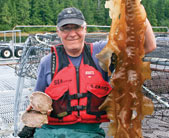Aquaculture 2.0
A UVic geographer pioneers a "new" kind of aquaculture that mimics BC's coastal ecosystem

by Peigi McGillivray
Thousands of years ago in China, people realized that when they kept shrimp in their carp ponds, the ponds stayed cleaner and the carp were healthier. This ancient technique of growing one species from another—known as polyculture—is the inspiration for a new kind of multi-species aquaculture evolving on BC's west coast.
Dr. Stephen Cross, a marine ecologist in the University of Victoria's geography department, is developing an ecologically sustainable aquaculture system that brings together several native species, mimicking the natural ecosystem of BC's coastal waters. His Sustainable Ecological Aquaculture (SEAfood) System is under development in Kyuquot Sound, off Vancouver Island's northwest coast.
Cross is creating an environment where fish, shellfish, bottom-dwellers and seaweed live together as they do in the wild, in a way that benefits every member of the system.
"It all starts with sablefish, or other local, commercially valued fish," says Cross. "We feed the fish and place other native species around and beneath the fish enclosures to intercept the organic and inorganic wastes they produce and convert them into additional crops."
Oysters, scallops, mussels and cockles filter waste particles—and even sea lice. Spiny sea urchins keep the nets clean, sea cucumbers eat the solids that settle on the seafloor, and kelp and other seaweeds take up excess dissolved nutrients.
In this system, the wastes that fish naturally produce become a valued resource for the other species involved, rather than a polluting by-product, says Cross.
"The global demand for fish and shellfish is growing, and wild fish stocks are shrinking," he says. "The SEAfood system offers a sustainable way forward for aquaculture, increasing production to meet demand, protecting wild fish and the environment, and creating a source of income for coastal communities. We believe it is a model that can work anywhere in the world—with different species."
The five-year SEAfood project is still in its pre-commercial stages, and is supported by the Natural Sciences and Engineering Research Council, Fisheries and Oceans Canada, and industry.
Cross's research team, which includes graduate students, is working with local First Nations communities, industry and research partners from academic and federal institutions across Canada. The pilot farm in Kyuquot Sound is the first licensed facility of its kind in Canada.
There, the team is examining and optimizing interactions among the co-cultured species, establishing the most ecologically sustainable physical set-up, looking for ways to integrate alternative energy components, and studying the socio-economic implications for local communities.
Future plans include a cluster of four SEAfood facilities in the Kyuquot area, producing sablefish and indigenous chinook salmon. "For each kilogram of fish we produce, we'll generate about a kilogram of kelp, five dozen oysters, half a dozen scallops, and a couple of sea urchins and sea cucumbers," says Cross. "And it will all meet the new national organic standards for aquaculture."
While the SEAfood system will not solve all the challenges facing the aquaculture industry in BC, says Cross, it does address many of them, and provides a sustainable, ecological source of high-quality, organic seafood to meet growing worldwide demand.View as PDF (660K).
An innovation hub
At the University of Victoria, new knowledge doesn't stop at campus boundaries. The purchase by UVic of the Vancouver Island Technology Park (VITP) from the provincial government in 2005 placed the university front and centre in the effort to diversify the economic life of our region by supporting high-technology enterprise.
With the acquisition, UVic now owns and manages more technology transfer space than any other BC university—great news for spin-off companies and the many graduates and co-op students employed by VITP tenants.
More importantly, by linking local, provincial, national and international resources with emerging tech companies, VITP has continued to shape the growth of the Island's $1.67-billion-a-year high-tech industry, an economic footprint that surpasses even the $1.19 billion annual activity of local tourism.
Because the park's 191,000 square feet of space has been nearly 100 per cent occupied for years, an expansion is planned to accommodate demand for high-tech development space in the future.
Info: vitp.ca